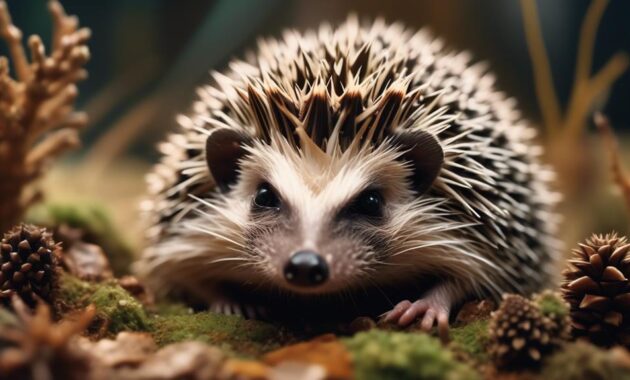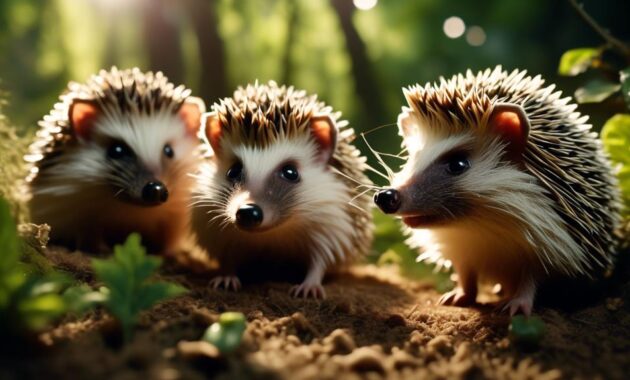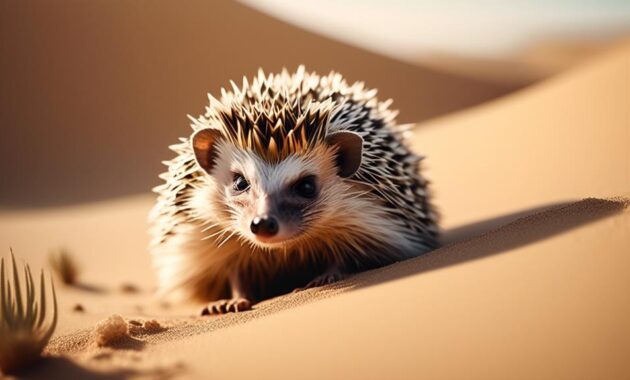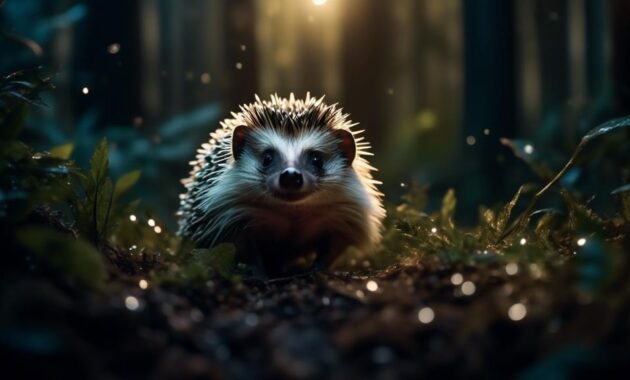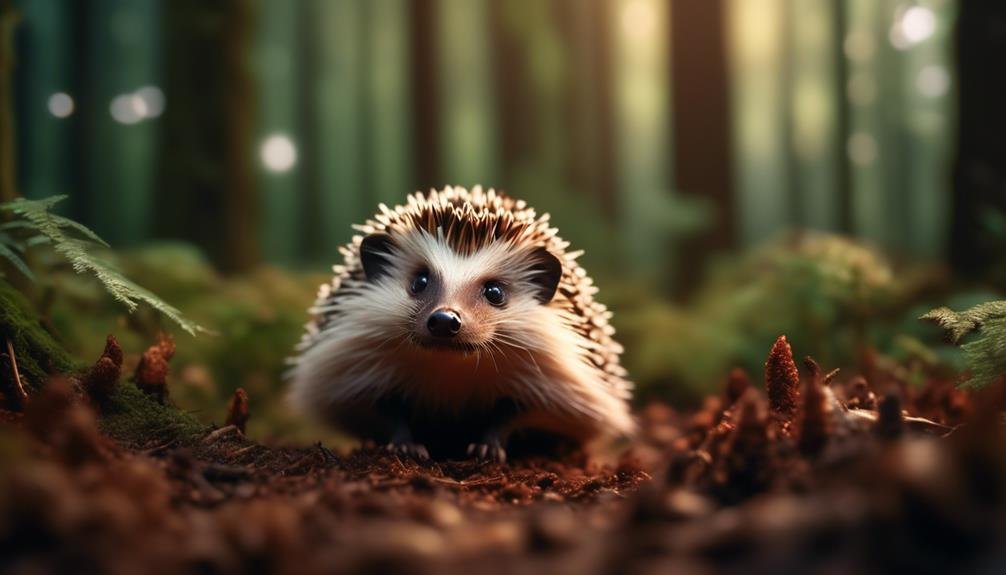
The Amur hedgehog, a fascinating and resilient creature, captivates both researchers and wildlife enthusiasts with its rarity and remarkable adaptability. From its unique physical characteristics to its ability to thrive in diverse environments, there is much to uncover about this mighty hedgehog.
In this discussion, we will explore its intriguing description and physical attributes, its distribution and preferred habitat, its reproductive behaviors, and its defense mechanisms and adaptations.
Additionally, we will delve into its nocturnal foraging habits, its torpor and hibernation patterns, its conservation status, and even its lifespan in captivity and the wild.
Prepare to be intrigued by the extraordinary nature of the Amur hedgehog and its ability to thrive in the face of adversity.
Key Takeaways
- The Amur hedgehog is closely related to the European hedgehog, but slightly larger and lighter in color.
- It is found in regions of Russia, China, and the Korean Peninsula, occupying a wide range of habitats including grasslands, forests, and cultivated land.
- The Amur hedgehog is a nocturnal species that forages for a variety of small arthropods, worms, and occasionally fruit.
- Despite its name, the Amur hedgehog is not considered rare and is assessed as least concern by conservation organizations.
Description and Physical Characteristics
The Amur hedgehog, closely related to the European hedgehog, is slightly larger and lighter in color, making it distinct in terms of its physical characteristics. It has a head-and-body length of 160-290mm and a short tail. Weighing between 600-1,000g, it is covered in long, sharp spines of two different colors. The quills on its head are separated by narrow strips of bare skin.
Found in Amur Oblast and Primorye in Russia, Manchuria in China, and the Korean Peninsula, its range extends from about 29°N to the Amur Basin and the Korean Peninsula. The Amur hedgehog occupies a wide range of habitats including grassland, forest edges, mixed coniferous and broadleaf woodland. However, it is not found in highland regions or cultivated fields. Suitable habitats also include montane and sub-alpine terrain, steppe, shrublands, cultivated land, villages, and city parks.
Distribution and Habitat
Amur hedgehogs can be found in various habitats across Amur Oblast and Primorye in Russia, Manchuria in China, and the Korean Peninsula. Their range extends from about 29°N to the Amur Basin and the Korean Peninsula.
These resilient creatures occupy a wide range of habitats, including grasslands, forest edges, mixed coniferous and broadleaf woodlands. However, they are not found in highland regions or cultivated fields. They are also known to inhabit suitable habitats such as montane and sub-alpine terrain, steppe, shrublands, cultivated land, villages, and city parks.
Amur hedgehogs have adapted to survive in diverse environments, showcasing their ability to thrive in various ecological settings. Their distribution across these regions highlights their resilience and adaptability as a species.
Reproduction and Behavior
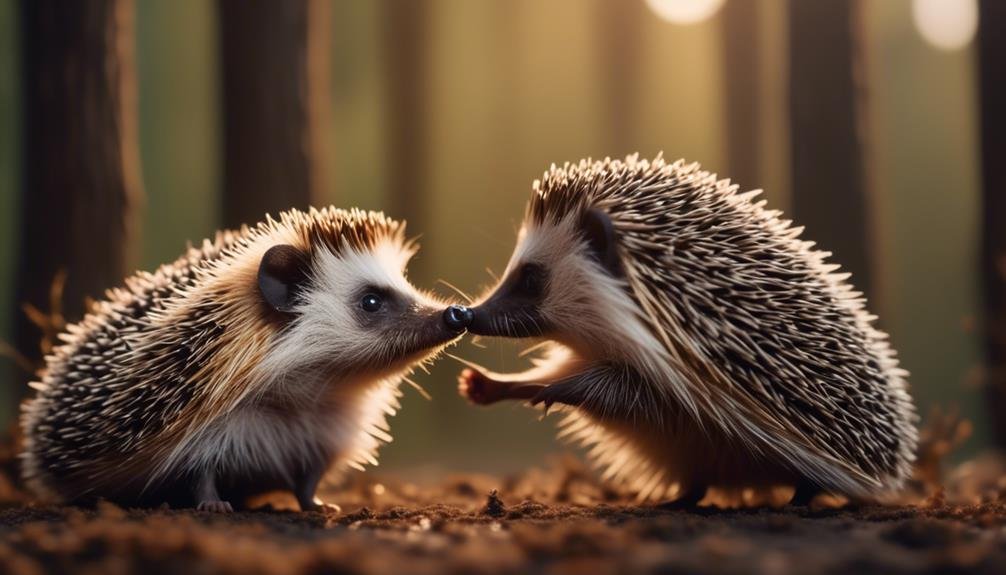
With their ability to adapt and thrive in diverse environments, it is intriguing to explore the reproduction and behavior of the resilient Amur hedgehog.
Although there is no specific information available regarding their reproduction, it is known that Amur hedgehogs typically come together during mating season.
They are nocturnal species that forage for small arthropods, fly larvae, earthworms, centipedes, snails, mice, frogs, and occasionally fruit.
They enter torpor and hibernate until spring in October.
When threatened, their defense mechanism involves curling up into a ball with their quills facing outwards.
During the summer, they give birth to one or two litters consisting of four to six young.
Despite being a common species with no specific threats identified, their lifespan in their native lands is unknown, while in captivity, it is about 8 years.
Nocturnal Foraging and Diet
During the nighttime hours, the Amur hedgehog engages in foraging activities and maintains a diet consisting of small arthropods, fly larvae, earthworms, centipedes, snails, mice, frogs, and occasionally fruit.
As a nocturnal species, the hedgehog relies on its keen sense of smell and hearing to locate its prey. It uses its sharp claws and teeth to capture and consume its food.
Small arthropods such as insects and spiders are a staple in its diet, providing essential protein. Fly larvae and earthworms are also important food sources, offering a good source of nutrients. Additionally, the hedgehog may consume centipedes, snails, and mice, which provide a more substantial meal.
Frogs and fruit are occasionally included in its diet, offering variety and additional nutrients. This diverse diet allows the Amur hedgehog to adapt to its environment and ensure its survival.
Defense Mechanisms and Adaptations
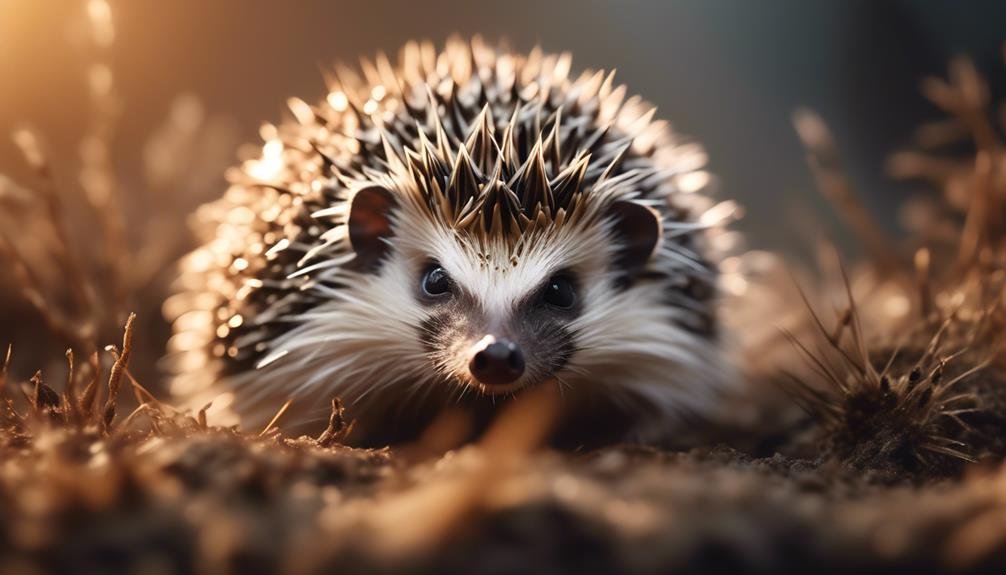
The Amur hedgehog possesses a range of defense mechanisms and adaptations to protect itself from potential threats. One of its primary defenses is its ability to curl up into a ball, with its quills facing outwards towards any potential predator. This allows the hedgehog to present a formidable barrier that is difficult for predators to penetrate.
Additionally, the Amur hedgehog has a unique feature of long, sharp spines of two different colors, which not only provide physical protection but also serve as a warning to potential predators. These spines can be raised and lowered as needed, providing the hedgehog with additional control over its defensive posture.
Reproduction and Life Cycle
The reproductive cycle and life stages of the Amur hedgehog are characterized by distinct behavioral patterns and adaptations.
- During mating season, Amur hedgehogs typically come together to reproduce, otherwise, they can survive on their own without any partnership.
- They have one or two litters in the summer, consisting of four to six young.
- After giving birth, the hedgehog enters torpor and hibernates until spring in October.
These adaptations allow the species to maximize their chances of survival and ensure the continuation of their population.
While specific information regarding reproduction is not available, the Amur hedgehog’s ability to reproduce and adapt to various habitats contributes to its resilience as a species. With no specific threats identified and assessed as least concern by the International Union for Conservation of Nature, the future of the Amur hedgehog appears to be secure.
Torpor and Hibernation Patterns
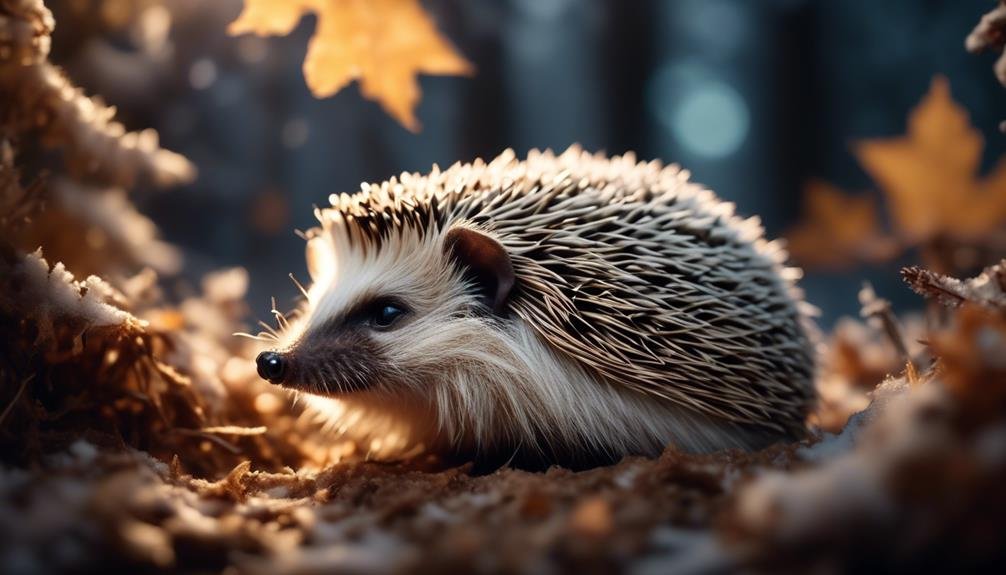
Revealing a unique aspect of the Amur hedgehog’s life cycle, its torpor and hibernation patterns play a crucial role in its survival and adaptation to changing environmental conditions.
In order to cope with the harsh winters of its habitat, the Amur hedgehog enters a state of torpor and hibernation from October until spring. During this period, the hedgehog’s metabolic rate decreases significantly, allowing it to conserve energy and survive the scarcity of food resources.
The hedgehog curls up into a tight ball, with its quills facing outwards, as a defense mechanism against potential predators. This behavior not only provides protection but also helps to conserve body heat.
The ability to enter torpor and hibernate is a remarkable adaptation that enables the Amur hedgehog to thrive in its challenging environment.
Status and Conservation Assessment
The status and conservation assessment of the Amur hedgehog is a crucial aspect of understanding and safeguarding the future of this remarkable species.
Currently, the International Union for Conservation of Nature has assessed the Amur hedgehog’s conservation status as ‘least concern,’ indicating that it is a common species with no specific threats identified. However, it is important to continue monitoring their population and habitat to ensure their long-term survival.
Conservation efforts should focus on preserving suitable habitats for the Amur hedgehog, such as grasslands, forest edges, and mixed woodlands. Additionally, raising awareness about the importance of protecting this species and implementing measures to reduce human-wildlife conflicts can contribute to its conservation.
Lifespan in Captivity and Wild

Comparing the lifespans of Amur hedgehogs in captivity and the wild provides valuable insights into the factors that may influence their longevity. In captivity, Amur hedgehogs have been known to live up to 8 years. However, information regarding their lifespan in the wild is currently unknown.
Factors such as habitat quality, availability of food, predation, and human interference can all play a role in determining the lifespan of these hedgehogs in their natural environment. In captivity, hedgehogs are provided with a controlled and consistent diet, protection from predators, and veterinary care, which may contribute to their longer lifespan.
Understanding the differences in lifespan between captivity and the wild can help conservationists develop strategies to enhance the survival and longevity of Amur hedgehogs in their native habitats.
Miscellaneous Information
Additionally, it is worth noting that there is limited available information regarding the specific reproductive behaviors of the Amur hedgehog species. This lack of information makes it challenging to fully understand the mating habits, gestation period, and parental care exhibited by these intriguing creatures.
Researchers have yet to uncover the specifics of how Amur hedgehogs reproduce, leaving a gap in our knowledge regarding this aspect of their lives. However, it is known that Amur hedgehogs typically only come together during the mating season, and one or two litters consisting of four to six young are born in the summer.
Despite this limited understanding of their reproductive behaviors, the Amur hedgehog remains a fascinating and resilient species worthy of further study and conservation efforts.
Frequently Asked Questions
How Do Amur Hedgehogs Defend Themselves From Predators?
Amur hedgehogs defend themselves from predators by curling up into a ball with their sharp quills facing outwards. This defense mechanism is effective in deterring potential threats and keeping them safe from harm.
What Is the Typical Diet of an Amur Hedgehog?
The typical diet of an Amur hedgehog consists of small arthropods, fly larvae, earthworms, centipedes, snails, mice, frogs, and occasionally fruit. They are nocturnal foragers and have a defense mechanism of curling up into a ball with quills facing outwards.
How Long Do Amur Hedgehogs Typically Hibernate For?
Amur hedgehogs typically hibernate from October until spring. They enter a state of torpor and remain dormant during this period. However, the exact duration of their hibernation period is not specified in the available information.
What Are the Specific Threats That the Amur Hedgehog Faces in Its Habitat?
The specific threats faced by the Amur hedgehog in its habitat are currently unknown. However, this species is assessed as least concern by the International Union for Conservation of Nature, indicating that no specific threats have been identified.
How Do Amur Hedgehogs Reproduce and Care for Their Young?
Amur hedgehogs reproduce by mating during the breeding season, with one or two litters produced in the summer. The young, consisting of four to six offspring, are cared for by the mother. The specific details of their reproductive behavior are not available.
What Contributes to the Resilience of the Amur Hedgehog Population?
The daurian hedgehog population comeback is attributed to several factors contributing to their resilience. Their ability to adapt to various habitats, from forests to grasslands, ensures their survival. Additionally, their low birth mortality rate and ability to forage for a wide variety of foods also play a significant role in their population resurgence.
Conclusion
In conclusion, the Amur hedgehog is a rare and resilient species known for its unique physical characteristics and remarkable adaptability.
With its diverse habitat range and ability to thrive in various environments, this hedgehog showcases its adaptability and resilience.
Despite its solitary nature, the Amur hedgehog continues to capture the attention of researchers and wildlife enthusiasts.
As a species of least concern, it remains a captivating and enigmatic creature in the animal kingdom.

